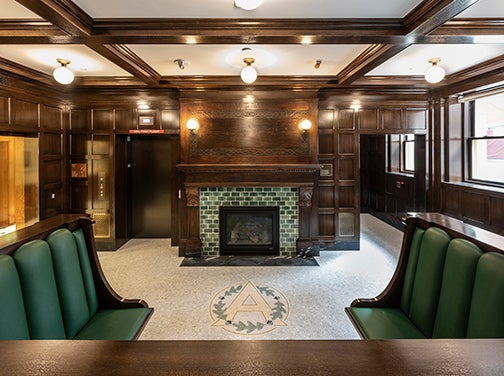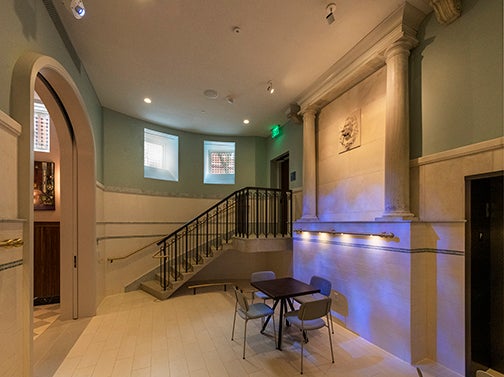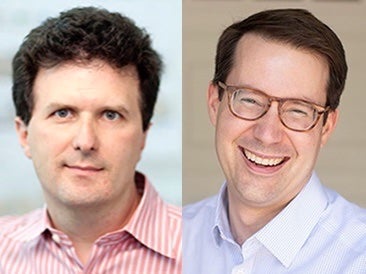Aaron Lamport ’90, P’23
Dunster House
Visual and environmental studies concentrator
Nate Rogers ’05
Quincy House
History of art and architecture concentrator
What makes a House a home? We asked two alumni deeply involved in House Renewal. Architects Aaron Lamport ’90, P’23 and Nate Rogers ’05 have helped to reenvision these hearts of Harvard in their work for Beyer Blinder Belle (BBB), an architecture and planning firm involved in House Renewal design since 2012. Lamport, a principal at BBB and senior project manager, and Rogers, a senior associate and project designer, most recently collaborated on renewal efforts at Adams House. They share what they think makes Houses so important, why they love Adams, and the things they’ve found in the basements.
How long have you been helping to shape Harvard’s House Renewal efforts?
Aaron: I’ve been involved since just before the Leverett House renewal, when we were working with swing housing and grappling with the question: What is the identity of a House when the community is not living there? It was the first opportunity to take those ideas and say: How do we create a new home and make sure the House hasn’t lost that feeling? This was a great introduction to the approach of the Faculty of Arts and Sciences (FAS) to Renewal. I then worked on the initial feasibility studies for Beren Hall at Winthrop House, segued into the full renewal project for Winthrop, and now I am working on Adams House.
Nate: I joined the Winthrop renewal effort in 2013 as a junior architectural designer. When we had the opportunity to compete to be the architects for Adams, I was thrilled to be a part of it. My dad is an Adams alumnus [Peter Rogers ’76]. When I was a kid, we’d go back to Adams for Reunions, tour the tunnels, and look at the student murals. Being in Adams at a very young age made a real impression on me.

House Renewal is such a huge effort involving many. What’s it like collaborating at this scale on something so integral to the Harvard experience?
Aaron: I feel like I’m the conductor, orchestrating the project not only within our office but also among our large consultant team. We work with mechanical, systems, and structural engineers; civil engineers; landscape architects; lighting designers; acousticians; food service consultants; and vertical transportation consultants. It’s a wide range of disciplines and all have to be coordinated.
Nate: Aaron and I work hand in hand with our managing partner, Liz Leber, who’s been with the Harvard projects all along. The three of us coordinate issues of design across all of these disciplines. Ensuring quality design is executed well in the field within historic buildings can be a big challenge.
What’s it like having lived in the Houses to now be on the frontline of their renewal?
Aaron: It’s been great for the chance to go back and reflect on our experiences in the Houses. It was almost like pulling back a curtain and realizing: Wow, the House as an idea didn’t just emerge on its own. It came into being because people have been thinking for years about what that experience is and how we can nurture it.
Nate: I constantly reflect back on my time in Quincy, as well as memories of visiting friends in other Houses and understanding what made each House different physically and culturally. What was it about a particular building layout or architectural space that led to more interaction?
How has your view of House life differed from project to project?
Nate: We thought deeply about the specific DNA of each House, and even each building—what it is that makes them different. What’s that sense of place that you can’t shortcut or fabricate? It’s certainly something that evolves and emerges organically since these Houses were created.
Aaron: Each of these buildings has its own character and culture, shaped in part by the faculty deans and tutors. That’s what makes House Renewal so exciting. How are you helping those people physically build community? It’s not just that these buildings are getting a little old and we have to fix things up. It’s more about: How in this age are you drawing students out of the room? How are you getting them to interact with their peers, their tutor, and the larger House community?

What’s it like talking to other alumni about House Renewal and sharing what kinds of changes we’re making to meet the needs of the 21st-century student?
Aaron: When you come across Harvard alumni, the first question usually isn’t, “What year were you?” It’s “What House were you in?” We’ve given tours of renewed Houses to alumni during Reunions and to see their reactions has been an incredibly rewarding experience.
Nate: BBB does a lot of work on higher education campuses, and we’ve noticed there's a real distinction between working on academic buildings versus dormitories. Unlike other buildings, dormitories are homes, filled to the brim with memories. For alumni who come back and visit, their memory of where and how they lived is so vivid. It’s been so interesting to engage with alumni—including our fellow classmates—to talk about the extraordinary benefits of renewal and also reassure people that they can keep their memories while the Houses necessarily change and evolve to support today’s students. These buildings need care and attention. The work of renewal won’t diminish what alumni experienced and remember from their own college years.
At a larger scale, I'm really fascinated with Harvard as both a physical and intangible place. And I love coming back to Cambridge. The Square is always changing, but it’s still the Square.
Aside from your professional roles, you are both deeply involved with Harvard as alumni, volunteers, and consistent donors. What motivates you to stay so engaged?
Nate: I met my wife [Katherine Allidah Muller ’05] as an undergrad and a lot of our friends are alums. I think it’s really important to stay involved and connected to our classmates. We love coming back for Reunions.
Most recently, we donated to the Newell Boathouse renovation. I was a varsity lightweight rower, and I think I spent more waking hours in Newell than in Quincy. Like the Houses, Newell is just one more of these beloved buildings, full of memories. The incredible set of activities they contain and the personal growth they nurture is what makes Harvard, Harvard.
Aaron: As an alumnus, I’ve been trying to stay engaged in theater and very specifically CityStep Harvard, which I was involved in as a set designer and technical director. That experience was about broadening your horizons, getting you active, and becoming involved in the larger community. I also have two kids, both in college now. One is a senior at Harvard. House life has been an integral experience for her, too. These communities are so incredibly important.
What's the weirdest thing you've ever found in the Houses?
Aaron: If you have an opportunity to visit Winthrop House, head down to the lower level and you can see a display case of some of the neat things we found during Winthrop construction. On one of the Adams buildings, we were actually digging out an elevator shaft and had to stop work because we came across some bones. It was a relief when the archeologist confirmed they were horse bones, not human bones. The best guess is this was the remains of one of the many workhorses around cities in the 1890s— perhaps this one helped to haul the massive granite foundation blocks to the building site.
Nate: The bones were probably the weirdest thing we’ve come across, but I’ll add that the construction crews frequently find some interesting litter inside the walls, like newspapers or soda cans from 50 or 100 years ago. These end up being unintentional time capsules.
It's always fascinating to be in these buildings, especially during the demolition phase, because you get such a sense of the history and layers. The Houses have led long lives and have witnessed so much.
Adams House photos by Peter Vanderwarker
